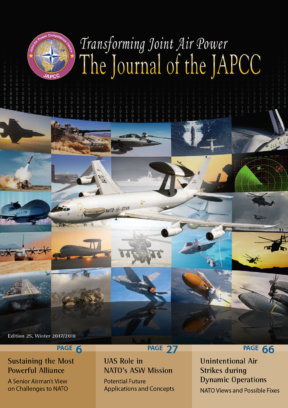Introduction
Spurred by a desire to extend their influence in the world through sea power, many nations recognized in the early 1900s airborne assets would become a fundamental component of maritime warfare. Consequently, many traditional maritime powers have celebrated the 100th anniversary of their Naval Aviation services within recent years, starting with the UK Royal Navy in 2009, the French Aeronavale in 2010, the US Navy in 2011, and the Italian and German Naval forces in 2013.
While air power is relevant in every domain, maritime air assets are crucial as Fleet defence tools primarily. They are under the command and control (C2) of the Maritime Component Commander (MCC) as an organic element to fulfil his mission. However, maritime aircraft are multi-role assets that could also support each of the other Single Service Commands (SSCs) and the Joint Commander. In fact, they are especially adept at doing so when coordinated by proactive inter-service liaison elements.
Mobility and Access in the Maritime Domain
The main advantage of naval forces is mobility and access. Worldwide mobility is guaranteed by the ‘freedom of navigation’ (to include overflight) in international waters, a principle that has been codified in international customary law1. Taking into account that the Earth is covered mostly by water and that 80 percent of the world’s population lives within 100 miles of the coast2, naval forces and their naval aviation assets have easy and legal access to almost any potential crisis region worldwide as well as the right to stay in close proximity.
Such capability may be considered key to success in many military operations. Warships with flight deck capabilities can be quickly deployed forward and act as mobile airbases with the advantages of faster response times and lower fuel requirements due to their proximity to the target area. Furthermore, operations can be conducted with relative safety, since the stand-off distance of the units afloat makes them less vulnerable to incursions and terrorist attacks compared to a land-based Deployed Operating Base near or inside the crisis zone. Furthermore, offshore flight preparations and activities may be less susceptible to enemy intelligence operations, thus providing higher levels of covertness.
Utility of Organic Embarked Maritime Rotary Wing Assets
The utility of Maritime Rotary Wing (RW) assets for naval and joint operations is sometimes overlooked. Apart from being the ‘long arm’ of their mother warships, these assets can be employed in many ways in support of the other SSCs, while their peculiarities must be carefully considered.
Anti-Submarine Warfare (ASW). Although submarine inventories were initially reduced globally after the end of the Cold War, there is a growing trend of non-Allied submarine operations in all sea areas relevant to NATO operations. In recent years, almost every nation claiming a submarine capability has expanded its current inventory with more advanced and less detectable submarines. The protection of a maritime force against submarines consists of ‘defence-in-depth’ and close coordination among friendly ships and submarines, helicopters, Maritime Patrol Aircraft (MPA), and shore-based facilities. Maritime ASW helicopters, in particular, have increased in importance due to the decreasing number of MPA available in NATO3. These helicopters are equipped with maritime radars optimized to detect submarine snorkels or periscopes. Integrated dipping sonars and dropped active/passive sonobuoys can be used to detect and track contacts. Electronic Support Measures (ESM) technology and mounted Magnetic Anomaly Detectors (MAD) are able to confirm the presence of submerged threats, while data link capabilities provide real-time information to the Fleet. Last but not least, ASW helicopters can be fitted with air-launched torpedoes, which allow them to attack and destroy enemy submarines.
Anti-Surface Warfare (ASuW). ASuW involves action against adversary’s ships to achieve sea control or sea denial, to disrupt their sea lines of communication, or to defend against a surface threat. For ASuW missions, helicopters can rely on maritime radar, advanced forward looking infrared (FLIR) systems, ESM receivers, and data link to inform about adversary contacts located over-the-horizon, i.e. beyond the range of sensors implemented on their mother ships. For identification purpose, contact data can be cross-referenced with information available on open source vessel traffic services, such as the Automatic Identification System (AIS) used for collision avoidance on merchant ships. When fitted with anti-ship missiles, maritime helicopters can attack enemy vessels directly while chaff and flare dispensers are used for self-defence.
Support to Joint Intelligence Surveillance Reconnaissance (ISR). The usual types of NATO maritime helicopters (e.g. EH101/Merlin, SH90, MH60R) serving on carriers, escort units, or other independently operating warships, are both ASW and ASuW capable while equipped with well-performing sensors capable of collecting intelligence not only for naval purposes but also to satisfy joint or other services’ ISR collection requirements. However, these assets are limited in range, altitude and endurance compared to other collection platforms such as Maritime Patrol Aircraft.
Anti-Air Warfare (AAW). In a joint operation, maritime AAW is part of the overall Air Defence (AD) effort. US and French catapult-assisted carriers use E-2C aircraft for Airborne Early Warning (AEW), while other NATO Navies with Short Take Off and Landing (STOL) carriers rely on dedicated Helicopter Early Warning/Airborne Surveillance and Control (HEW/ASaC). These are equipped with sophisticated radar pickets, capable of accurate detection and automated tracking of aerial threats to the Fleet. While the E3-AWACS provides AEW and C2 capabilities much superior to those of HEW assets, their availability cannot always be promptly granted for many reasons, as evidenced in the first five days of Operation Odyssey Dawn in Libya4. Apart from this, HEW/ASaC radars can also observe suspicious ground movements in support of friendly land forces ashore, and direct friendly air, sea or ground forces to intercept the enemy, as UK forces did with devastating effect during the fighting in southern Iraq in 20035. HEW/ASaC may therefore at times become the best alternative option for naval or joint commanders, or possibly the best option for supporting amphibious operations.
Sea-based Joint Personnel Recovery (JPR). Most NATO Navies operate maritime transport RW assets to support Amphibious Operations with troop lifts and other logistic missions. Usually, these medium-to-heavy lift helicopters can also be fitted with material and litters for Medical Evacuation (Medevac) purposes. Maritime RW in the amphibious assault configuration therefore constitute the backbone of a sea-based JPR capability, as already implemented by NATO forces with great effect during Operation Unified Protector6. These assets have also been widely flown by many NATO nations in different land-focused theatres such as Kosovo, Iraq, and Afghanistan, providing Combat Support and Combat Service Support to land troops and Special Ops units.
Command and Control of Maritime Air Assets
Organic maritime air assets are under the control of the Maritime Component Command (MCC). While their sorties are planned and tasked through the MAOC (Maritime Air Operation Centre), all air missions must be coordinated with the joint level and appear on the Air Tasking Order (ATO) issued by the Joint Force Air Component Command (JFACC). This is to ensure overall air space control and coordination and minimize the risk of fratricide or interference with the overall air defence plan. Therefore, the MAOC is required to file an ‘ATO feeder’, which identifies planned maritime air sorties, with the JFACC. When not all maritime air assets are required for the MCC’s daily mission, the excess capacity can be declared available for sorties in support of the other single service components (SSCs) as directed and apportioned by the Joint Force Commander (JFC) as well as coordinated by the JFACC.
Joint Planning of the air campaign at the operational level, and the coordination between the MCC and the JFACC, is reached through the presence of liaison elements. The MCC provides a Maritime Liaison Element (MLE) and, for all air-related issues, a Maritime Air Liaison Element (MALE) to the JFACC. Conversely, the JFACC sends an Air Liaison Element (ALE) to the MCC. The coordinated execution of current air operations is implemented at the tactical level through the presence of a Maritime Coordination Element (MCE) and a Maritime Air Coordination Element (MACE) in the JFACC. The JFACC will conversely detach an Air Operation Coordination Centre Maritime (AOCC-M) to the MAOC. These air and maritime liaison entities report to and remain part of their parental command structure, but become functionally part of the headquarters to which they are attached.
The quality and competencies of the liaison elements representing the MCC at the JFACC and JFC are of utmost importance. The MLE and MCE must be able to communicate the maritime operational picture and coordinate joint operations with their parental headquarters. As well, MALE and MACE personnel must have deep knowledge of the capabilities of available maritime air assets, to include the utility of RW assets as described above, to recommend their appropriate employment in support of the other SSCs.
The support provided by maritime liaison entities during recent NATO crisis operations was critical. Maritime advocacy repeatedly proved its significance for the success of the joint effort. However, this comprehension often came late. Joint and service commanders experienced considerable difficulties in collaboration during the early phases of NATO operations since virtually none of the coordination instruments are common knowledge and no such liaison elements are implemented amongst the SSCs during peacetime. Not surprisingly, limited joint interaction and SSC ‘stove-piping’ could be observed in this regard during recent major joint exercises such as Trident Juncture 20157. The peacetime liaison issue has also been recognized as a shortfall during the Maritime Air Coordination Conference8 held in Northwood (UK) last spring.
Conclusion
The nature of potential conflict zones and the likely scarcity of feasible military airbase facilities ashore may make maritime air assets a key enabler in future Alliance operations. Maritime forces can be quickly deployed, have free mobility, and can easily gain access to the area of operation.
While the use of embarked air assets, especially RW, is essential for the MCC to ensure its own defence and project (amphibious) power ashore, excess capacity can be made available to support the Joint Commander and fellow SSCs in their missions. The knowledge of the particular capabilities of these flexible and highly effective assets and how to efficiently plan and direct their contribution within the joint environment is crucial.
A strong proactive liaison can help reduce friction and confusion in coordinating air and maritime air asset employment during the early stages of future Alliance operations. Therefore, NATO should examine the feasibility of implementing standing peacetime liaison elements at the operational level between AIRCOM and MARCOM, and between the JFACCs and MCCs standing-by as part of the NATO Response Force (NRF). This might substantially contribute to better preparation through education, exercise, and training, thus ensuring and increasing professional decision-making in this field, and therefore considerably strengthening NATO deterrence.












